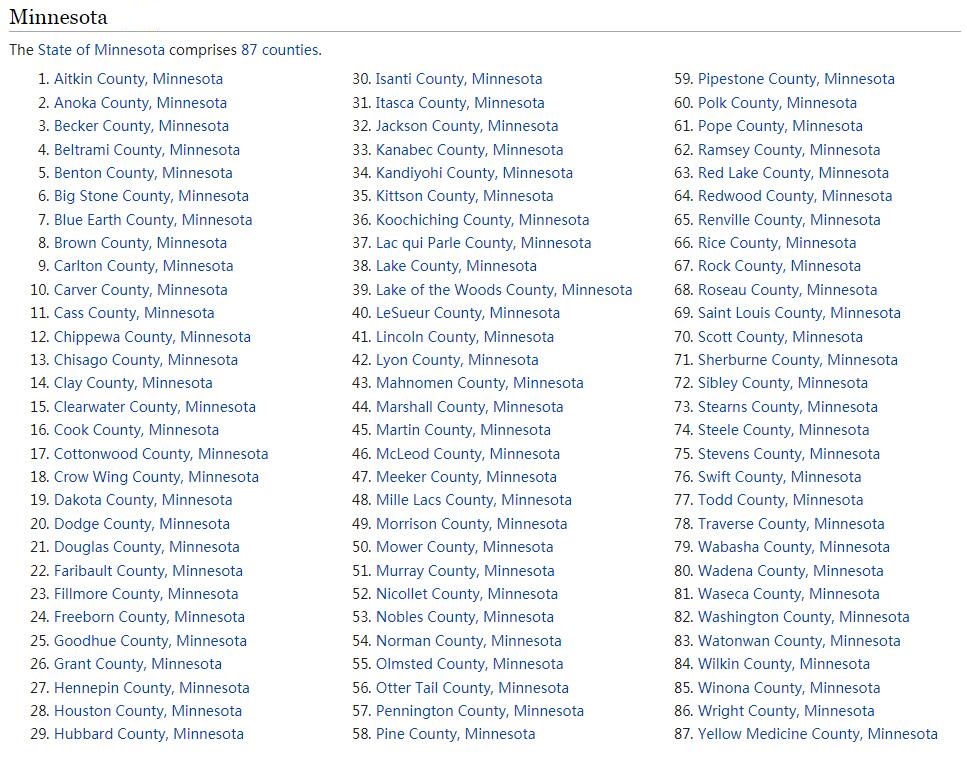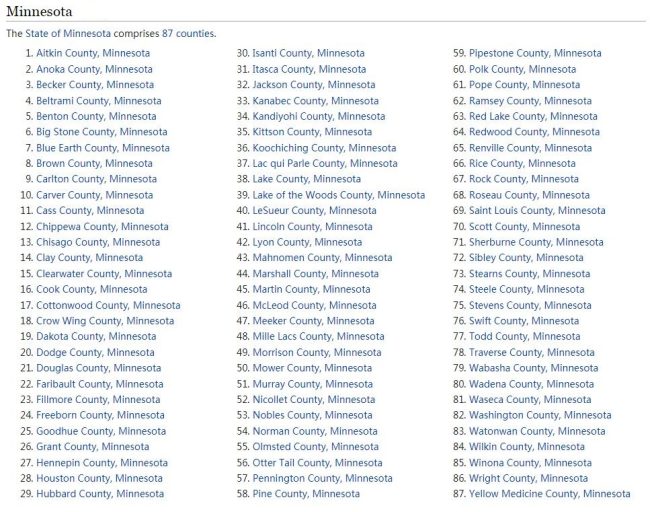Minnesota is one of the 50 states of the United States of North America. The state is located in the Midwestern region of the US and has a population of 5,344,861. The capital is Saint Paul and the standard abbreviation for the state is MN.
Minnesota borders Wisconsin to the east, Iowa to the south, and North Dakota and South Dakota to the west. To the north, the state borders Canada.
The Mississippi River has its source in northern Itasca State Park. The river forms part of the border with Wisconsin.
Minnesota is quite flat. Most of the state is prairie land.
The northeast of the state is located in the Superior Upland. This is a southern spur of the Canadian Shield.
The highest point in the state is Eagle Mountain with an elevation of 701 meters.
Lakes and Rivers
The Mississippi and its tributaries, including the Minnesota and St. Croix, drain most of the state.
Minnesota has more than 20,000 lakes, mostly in the north and center of the state. The largest lake is Red Lake
. About 5,700 km2 of Lake Superior (Lake Superior) lies within the boundaries of Minnesota.
Source Mississippi
River The Mississippi River is the second largest river in North America with a length of 4,070 kilometers. The Missouri, a tributary of the Mississippi, is the longest river in North America at 4,370 kilometers in length.
Lake Itasca, in northwestern Minnesota, and the streams that feed this lake are considered the source of the Mississippi.
The river flows through, or along, the states of Minnesota, Wisconsin, Iowa, Illinois, Missouri, Kentucky, Tennessee, Arkansas, Mississippi, and Louisiana. The river flows into the Gulf of Mexico near New Orleans.
Climate and tourism
Minnesota has a continental climate, with cold winters and hot summers. Cyclones occur regularly in the state.
The state is a popular vacation destination for anglers, hunters, and boaters.
Frequently visited areas include the Boundary Waters Canoe Area, the Superior National Forest, and Voyageurs National Park.
Fort Snelling, which dates back to about 1820, is a reminder of the settlers who explored the area. The Pipestone National Monument highlights the culture of the Native Americans who lived in the area.
Cities Minnesota
The capital of Minnesota is Saint Paul. The largest city is Minneapolis. These cities abut each other on the banks of the Mississippi. They are therefore called the Twin Cities, “Twin Cities”.
Some other cities in the state are: Rochester, Duluth, Bloomington, Brooklyn Park, Plymouth, Saint Cloud, Eagan, Woodbury.
Maple Grove, Coon Rapids, Eden Prairie, Minnetonka, Burnsville, Apple Valley, Blaine, Lakeville.
Minnesota counties
Minnesota is administratively subdivided into 87 counties.
Minnesota
Minnesota borders the states of Wisconsin, Iowa, North Dakota, and South Dakota. To the north, the state borders Canada. The capital is Saint Paul.
Grand Portage National Monument
The town of Grand Portage is located on the shores of Lake Superior in Michigan. In the past, it was a major trading center for the Northwest Company. This company was involved in fur trading from 1779 to 1821. Its headquarters were located in Montreal in what was then British North America, but it had its warehouses in Grand Portage.
All supplies were brought here from Montreal by canoe. Only in 1803 did the center move north of the American border, to the town of Fort William. Over time, the fur trade spread to the areas around Lake Athabasca. Explorers Alexander Mackenzie, Simon Fraser and David Thompson were mainly responsible for the development of fur industry in this region. They gradually reached the Rocky Mountains and along the banks of the rivers also to Georgia Bay on the west coast of Canada.
Today, Gran Portage is a place to step back in time. Here you can get to know the life of the then inhabitants as well as the original Indian tribes. It is also a great place for children to learn about the history of the country, the fur trade in a fun way, and they can also take part in various cultural and entertainment events that are held here regularly.
Voyageurs National Park
Voyageurs National Park, located in the north of the state of Minnesota, was declared in 1971. However, the first proposal to declare a park in these places was already made in 1891, but it was created only during the administration of President Nixon, a full 80 years later. Today it covers an area of 882 km2 and got its name from the “voyageurs”, who were French-Canadian fur traders. They were also the first European settlers who thoroughly mapped this landscape and traveled through it regularly.
As the park is interspersed with numerous water sources, it has become popular among canoeists, kayakers, rowers and fishermen. All of them will find excellent conditions for pursuing their interests here. The park is accessible only by boat, in winter, when the surface of the rivers is frozen, you can get here by snowmobile, skis or snowshoes. The government is trying to prevent or even ban the use of snowmobiles in the area. Their operation destroys the natural beauty of the park and the noise from them adversely affects wild animals.
The park also has large lakes, the most famous of which are Lake Kabetogama, Lake Namakan, Rainy Lake, Sand Point Lake and Crane Lake. However, Kettle Falls is also a popular tourist destination. The closest city around the national park is International Falls, Minnesota.



